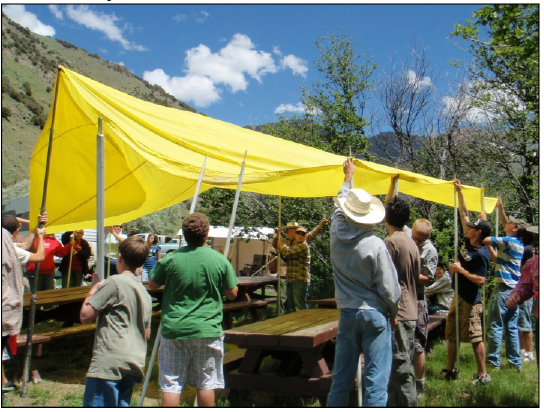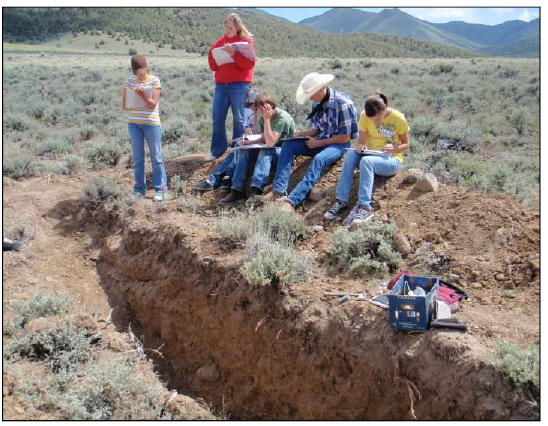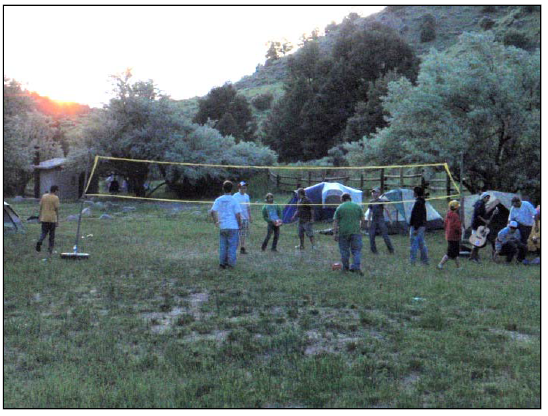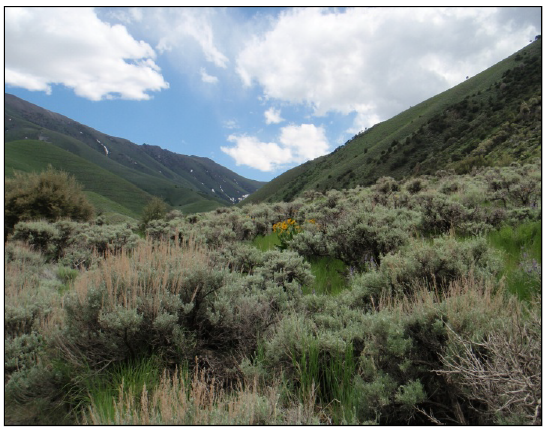Introduction
Since 1961, The Nevada Youth Range Camp (NYRC) has provided a week-long camping and instructional experience for high school-age youth from across Nevada and occasionally Northeastern California. University of Nevada Cooperative Extension faculty, along with specialists from the University of Nevada, Reno; Natural Resources Conservation Service; Bureau of Land Management; Forest Service; Nevada Division of Forestry; Nevada Division of Conservation Districts; Nevada Department of Wildlife; and others collaborate to provide a unique educational experience. The camp is sponsored by Cooperative Extension and the Nevada Section of the Society for Range Management. It receives financial assistance from Nevada Bighorns Unlimited, the Nevada Wildlife Federation, and many State Conservation Districts.

Purpose
Nevada Youth Range Camp focuses on relationships between people and rangeland. Campers learn that land managers need information about plants, wildlife, water and soil to make good decisions about rangeland management and use. They learn basic skills about rangeland and resource management and explore career opportunities in these fields. The camp challenges youth to explore resource problems and create logical solutions. A one week camp does not create rangeland managers out of campers. However, it helps future leaders develop the perspective to understand rangeland resources and their relationship to society.
Program
During the week, campers learn the importance of range plants, how to identify them, and their usefulness to livestock, wildlife and watersheds. They focus on the connections between range soils and vegetation. Campers study wildlife and learn about wildlife habitat conservation. A local rancher takes campers on a ranch tour and discusses range management from the business perspective of livestock production. Campers also use teamwork to develop and present a rangeland management plan for the area they worked in all week. They also implement a conservation project.
Schedule
Campers arrive by noon on Sunday and break camp the following Saturday morning. Campers register and form groups with an adult counselor and an assistant youth counselor. Assistant counselors are youth who previously attended the program. The daily program runs from 7 a.m. until lights out at 10 p.m.

Among the instructional topics are soils, stream ecology, water quality, sagebrush rangelands, pinyon juniper woodlands and wildfire, wildlife habitat, using a map and compass, the role of livestock ranching in the Great Basin and plant identification. There is time in the late afternoon and evening for rest and recreation, including fishing for trout in Big Creek.
Adult supervisors are present throughout the entire week. Parents and sponsors are welcome to visit the camp any time and are especially invited for the Friday night awards program. The evening programs are geared more for enjoyment and personal interest and include map and compass orientation, primitvie skills demonstration, wildlife presentations and campfires. At mid-week, a shower and swim at the Austin pool precedes the barbeque and special evening program.
In 2009, an evaluation of the camp program was conducted to measure participant gains in knowledge for the major curriculum topics. An increase in knowledge was evident in all areas tested, ranging from 10 to 54 percent increase in test scores between the pre-test and post-test.
| Subject Area Tested |
% Change |
| Rangeland Management |
+30% |
| Land Navigation |
+17% |
| Rangeland Soils |
+49% |
| Water Quality |
+54% |
| Rangeland Plants |
+31% |
| Sagebrush Rangeland |
+24% |
| Proper Function Condition of Riparian Areas |
+10% |
| Wildlife Management |
+17% |
The evaluation of behavior and attitude change of camp participants was determined with questions that were rated on a Likert scale of 1-5, (1 = Strongly Disagree, 5 = Strongly Agree). All questions received an average score of 3.38 or higher.

The following are the questions utilized to measure behavior/attitude changes and their corresponding scores:
| Questions |
Ave. Score |
| Has the Nevada Youth Range Camp increased your interest in studying range management in college? |
3.85 |
| Would you tell your friends to attend the Nevada Youth Range Camp? |
3.92 |
| Has your knowledge about Nevada’s rangelands improved? |
4.42 |
| Has your appreciation of Nevada’s rangelands improved? |
4.27 |
| Because of what you learned at Range Camp are you more willing to attend a public meeting about the management of Nevada’s rangelands? |
3.38 |
| After attending the Nevada Youth Range Camp, if you are provided the opportunity to write a report or assemble a project in your high school science classes, are you more likely to select a topic or issue related to Nevada’s rangelands? |
3.85 |
Summary
Nevada Youth Range Camp exposes high school students to the physical and biological foundations required to manage rangelands and their natural resources. Participation in Range Camp allows students to gain exposure to the educational and career opportunities available for the study and management of rangelands, which cover close to half of our planet’s continents. They learn this material through direct interaction with university faculty and career professionals employed by numerous federal and state agencies. A program evaluation has documented large increases in knowledge about rangelands and changes in perceptions about the importance and value of rangelands.
For more information about Nevada Youth Range Camp, visit the Nevada Society for Range Management Web site at NAES. Here you can find more information about camp, including dates and location of camp, how to apply for camp, a camp supply list and slideshows from past camps.

Foster, S., McCuin, G., and Schultz, B.
2009,
Nevada Youth Range Camp (History),
Extension | University of Nevada, Reno, IP-09-05


